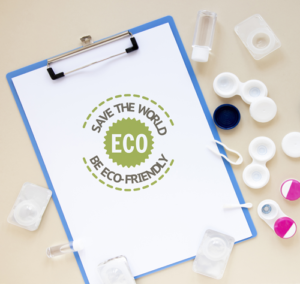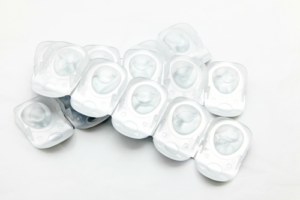
How to recycle contact lenses
In order to keep your contact lenses free from any damage or defend them against bacteria, it is recommended you to stick to the suggested replacement schedule: i.e. a new one every day/week/month. But how should they disposed of? What kind of waste are they?

What kind of waste are contact lenses?
We’ve become accustomed to recycling cardboard boxes, aluminium soda cans, plastic water bottles, magazines and other items. If you're a contact lens wearer and want to do your part to reduce waste, there’s a simple solution: learn how to recycle contact lenses, blister packs and their foil covers.
The idea of customers collecting and recycling their contact lenses is a relatively new one. While TerraCyle (a company that specializes in recycling items and object considered hard to recycle) and Acuvue have taken the lead in the UK. On the other hand, Bausch & Lomb is the only company that has a running contact lens recycling program in America.
Many chain and independent opticians are willing to take part in the scheme and hopefully such behaviour will spread worldwide as soon as possible. The end result will see the recycled contact lenses, blister and foil packaging turned into new products such as outdoor furniture and plastic materials.
What is the right way to dispose of contact lenses?
Contact lenses are not biodegradable and are generally made from plastic-type materials (polymers) such as hydrogel, silicone hydrogel, or non-hydrogel variants. It is important therefore that you never wash your used lenses down the sink or flush them down the toilet.
Due to their size and material, recycling facilities cannot handle contact lenses. They are not recyclable in any typical recycling program and they do not degrade. To keep them out of our ecosystem, find out whether there’s a contact lens recycling initiative near you or take the waste to a vision practice participating in a contact lens recycling program.
Scientists are currently working on a soy-based biodegradable contact lens, so in a couple of years, we can throw contacts in the organic waste. Now it’s required just a little bit of extra work on your part but that could make it a win-win solution to make a positive impact!
What can be recycled?
The packaging your contact lenses come in is made from a number of materials, most of which can be recycled. Cardboard packaging can be recycled in the standard paper bin.
The blister packs your contact lenses come in can be recycled in a way that requires very little time and effort. These are made from PP (polypropylene) plastic and are accepted for recycling. You should be sure the blister packs are free of liquid, then you can drop them into the plastic bin.
Remember to remove the foil that covers the blister packs. The top foil cannot be recycled and must be removed prior to recycling plastic blister packs.
Solution bottles and cases are usually made from PET or Polyethylene plastic. Place the empty bottles into the plastic recycling bin. Contact lens cases should be replaced regularly, but they can be repurposed in many creative ways. However, lens cases, including the cap closure, are all made of a mixture of plastics. Hence, if needs to be disposed of, they should go into the plastic bin.
Sustainability efforts from soft lens manufacturer

Blister packs can be recycled.
Karen K. Yeung and Robert Davis from Contact Lens Spectrum Magazine have recently analyzed how contact lens company have started to become environmentally conscious.
Menicon has been innovative with its environmentally friendly Miru 1Day Menicon flat packs. The flat packs are 1mm thick, so they have 80% less packaging and less saline compared to conventional blister packs. In addition, Miru 1 Day Menicon Flat Packs consist of foil of polypropylene plastic, so the entire flat pack is recyclable.
Johnson & Johnson Vision Care has partnered with TerraCycle to recycle contact lenses in the United Kingdom. The company also received the 2017 Environmental Leader award for Acuvue Oasys 1-Day by using sustainable packaging and reducing its packaging. The blister packaging for Acuvue Oasys was also redesigned to reduce polypropylene usage and paper packaging.
In 2016 Bausch + Lomb launched its exclusive ONE by ONE Recycling program in the U.S..
Moreover, B+L has implemented the use of biodegradable lens packaging for Biotrue ONEday range and Renu solutions and promoted the use of renewable energy in its production plants.
There are so many ways to make an environmental difference in our daily lives. Let us know if you have any cool ideas or tips of your own for living sustainably. Leave any messages in the comments below!

 EU
EU 









1 Comment